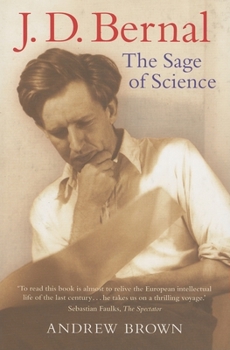J. D. Bernal: The Sage of Science
Select Format
Select Condition 
Book Overview
J.D. Bernal, known as "Sage," was an extraordinary man and multifaceted character. A scientist of dazzling intellectual ability and a leading figure in the development of X-ray crystallography, he was a polymath, a fervent Marxist, and much admired worldwide. Although he himself never won a Nobel Prize, several of his distinguished students went on to do so, including Dorothy Hodgkin, Max Perutz, and Aaron Klug. Andrew Brown has had unprecedented access to Bernal's papers and diaries, and this biography includes previously unpublished material on Bernal's role during the Second World War. Bernal not only changed the course of science, but was witness to (and often a participant in) historical events (the Easter Rebellion, the Great Strike, the anti-fascist movement and pacific causes, civil defense, RAF bombing strategy, the planning for D-Day, post-war rebuilding, and nuclear weapons.) One of the few men familiar with Downing Street, the White House and the Kremlin, he left fascinating accounts of Churchill, Stalin, Mao Zedong, Louis Mountbatten and Picasso, as well as the century's greatest scientists. Brown's compelling account covers all aspects of Bernal's brilliant, colorful, and bohemian life, and introduces this towering figure of 20th century science to a wide audience.
Format:Paperback
Language:English
ISBN:0199205655
ISBN13:9780199205653
Release Date:May 2007
Publisher:Oxford University Press, USA
Length:576 Pages
Weight:1.05 lbs.
Dimensions:1.5" x 7.7" x 5.0"
Customer Reviews
1 rating
The First Molecular Biologist
Published by Thriftbooks.com User , 17 years ago
.D.Bernal(1901-1972) was a genius level crystallographer who made original contributions to the study of protein structures in the early days of X-ray crystallography.The author portrays him as the first molecular biologist, although he was trained as a physicist. He worked at Birkbeck College and at the Royal Institution. He helped plan the D-Day landings in Normandy, and helped train proteges such as Dorothy Hodgkins and Helen McGaw.He served as an advisor to Lord Mountbatten in the far east. Unfortunately he was also an ardent communist and seemed to feel that scientific research was better organized in the USSR than in the west. He failed to condemn the Soviet liquidation of its geneticists or the biology of Lysenko. This in-depth biography contains many quotes from Bernal's extensive writings on subjects at the interface of science and politics. Not omitted are Bernal's many love affairs and open marriage. Many of the great figures of 20th century science come into this book, including Lord Rutherford(Bernal was one of two people Rutherford loathed),Francis Crick, Max Perutz( who was Bernal's student), John Kendrew ,"Solly" Zuckerman, William and Lawrence Bragg and Lord Cherwell ( the other person Rutherford loathed). The book will appeal most to the scientifically inclined, although there is nothing really technical to understand. Bernal came close to understanding the helical structure of DNA. Ironically Francis Crick wanted to work with Bernal, but was sent away by his secretary. The book started slowly, but became really interesting in the part about WW II as Bernal's career accelerated toward what seemed to be a crash over his communist ideas.We learn about the British plan(never realized) to construct a huge aircraft carrier out of ice reinforceed with wood pulp. Bernal was a true polymath, able to discuss diverse subjects such as art and architecure as well as science, and had the sort of mind that could comprehend and organize vast masses of data, making him valuable in tasks like assessing bomb damage during the Blitz. Overall, an absorbing interesting book.






